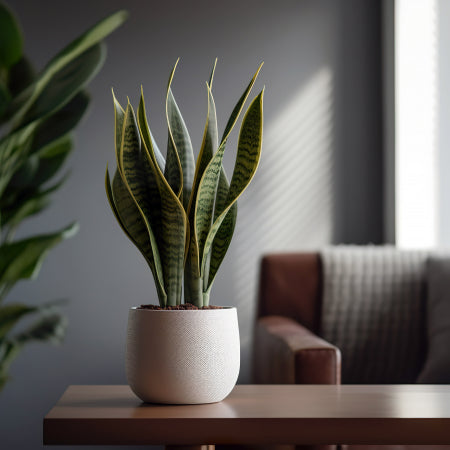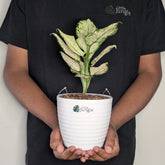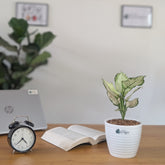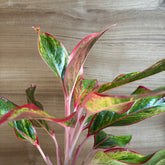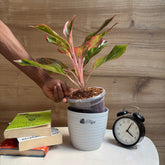10 Best Indoor Plants
Do you also face the problem where your green thumb turns sore whenever it comes to indoor plants? Well, it could be a lot of reasons for this to happen. Maybe you’re choosing the plants which are a little high maintenance. Or if you are a novice, you are most likely to either water them too much or too little or keep them directly in the sunlight or not keep them in any at all. Well, there is nothing to fret about.
Honestly, anyone can grasp the beauty of indoor gardening just by choosing the right plant for the respective microenvironments, whether the room is warm or humid or cool and low-light. And moreover, aren’t some plants tough enough to survive just about anywhere?
It doesn’t matter if you are an amateur or an expert, there is always an indoor plant for everyone!
In this blog, we shall be giving you a little insight as to some of the best indoor plants that you can keep with you!
10 Best Indoor Plants
1.POTHOS:
Scientific Name: Epipremnum pinnatum
The pothos is probably what comes to mind when you envision a houseplant. The plants, which are often referred to as golden pothos or devil’s ivy, have vivid heart-shaped leaves that can be either green or have a green and yellow marble pattern.
They require little more than sporadic watering and indirect sunlight to thrive. According to research, indoor ozone levels can be lowered by plants, which can improve breathing, lessen the chance of developing respiratory conditions, and eliminate volatile organic compounds (VOCs) from the air.
2.SPIDER PLANT:
Scientific Name: Chlorophytum comosum
Spider plants are incredibly low maintenance, easy to cultivate, and don’t need a lot of your time or energy. According to the University of Wisconsin-Madison Division of Extension, the plants feature narrow leaves and receive their name from the “small plantlets produced on long trailing stems that vaguely resemble spiders.”
It is well known that spider plants can help clean the air around them. According to NASA research, plants can function as a natural air filter to lower toxins in the air by examining the leaves, soil, roots, and microorganisms of several house plants. According to the study, over the course of a 24-hour period, spider plants were able to eliminate 95% of the harmful formaldehyde from the air in a sealed Plexiglas container.
3.PEACE LILY:
Scientific Name: Spathiphyllum
There is undoubtedly serenity associated with the moniker “peace lily.” These hardy plants “flower and have a pleasing appearance.”
Broad white blossoms that resemble a white peace flag are constantly produced by peace lilies, which have a long lifespan. They thrive in shaded areas since they require little light and are easy to maintain indoor plants. Simply keep them out of the reach of small children and pets since they may cause vomiting or swelling of the tongue if consumed.
4.SUCCULENTS AND CACTI
Cacti and succulents grow well with little to no maintenance. Because of their resistance to dryness, these plants only require watering when the soil is fully dry. They can help purify the air and embellish your home because they come in a variety of sizes and shapes.
Certain types, like the jade plant, have the ability to raise the humidity level in an area. Particularly, aloe vera plants have therapeutic qualities and can aid in the healing of burns, wounds, and other skin conditions.
5.ENGLISH IVY
Scientific name: Hedera helix
English ivy is a multipurpose plant that has been demonstrated to reduce airborne levels of formaldehyde, carbon dioxide, and pollutants. They can be cultivated indoors or outdoors. When grown inside, ivy thrives in hanging baskets and pots and can be trained to follow a trellis or other shape. When the soil dries out, it requires abundant watering and grows best in direct sunlight.
6.FERNS
Scientific Name: Tracheophyta
According to a 2022 study that was published in Applied Sciences, Boston ferns are the greatest at naturally removing volatile organic compounds (VOCs) from the air. Easy to grow, these plants look best inside in hanging baskets or on plant stands where their fronds can trail over the edge. They may take a little longer to grow because they require constantly wet soil and medium-bright light.
7.SNAKE PLANTS
Scientific Name: Sansevieria trifasciata
The snake plant, also referred to as “mother-in-law’s tongues,” has tall, vertically growing leaves. They require very little upkeep and are ornamental. The plants “thrive on neglect” and only require watering when the soil is dry. They also grow in any type of light. It has been demonstrated that the snake plant gradually eliminates pollutants from the air and was part of the extensive NASA study on indoor plants. It is the best indoor plant for oxygen!
8.RUBBER PLANTS:
Scientific Name: Ficus elastica
Rubber plants are excellent indoor house plants. They are also referred to as rubber trees or Ficus elastica. They just require weekly or so watering, and they are usually easy to maintain. Rubber plants have the ability to filter the air. Just make sure to keep them well out of the reach of small children and dogs, since they may be quite dangerous if consumed.
9.ELEPHANT EAR PLANTS
Scientific Name: Colocasia
Elephant ear plants are something Cromer suggests if you’d like to spend a little more time tending to your houseplants. These belong to a class of tropical perennial plants that are easily identified by their large, heart-shaped leaves.
They require regular watering to keep the soil moist, good sunshine, and possibly additional room because they can grow to be quite large. Some species have been cultivated for their starchy edible tubers, which constitute a staple in some tropical climates. The leaves have a history of being used medicinally to cure insect stings.
10.PARLOUR PALM
Scientific Name: Chamaedorea elegans
Use a parlour palm to add a touch of the tropics indoors. A popular option as office plant and foyers with low lighting. Usually, lower fronds that eventually turn brown on their own require only pruning. Healthy green fronds can be trimmed to totally stop growth. If you decide to prune, cut off the whole stem.
In conclusion, indoor plants not only add beauty to our living spaces but also contribute to cleaner air and improved well-being. With a variety of low-maintenance options like pothos, spider plants, and succulents, anyone can enjoy the benefits of indoor gardening. Whether you’re a novice or an expert, there’s a perfect plant for every environment, enhancing both aesthetics and health. So, why not bring a little piece of nature indoors and enjoy the countless benefits it offers?

